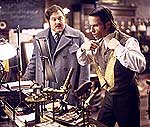
|
“The
Time Machine” not so timeless The new film version of H.G. Wells’ “The Time Machine” is like the gadget it takes its title from - shiny to the point of dazzling, a technical wonder. But like the Tin Man, this metal marvel lacks a heart.
Wells’ parable of the dangers of science run amok, of humanity’s adaptability and of planetary evolution moving at hyper-speed is ably adapted by once and future animation director, and Wells descendent, Simon Wells (”The Prince of Egypt,” “Balto”). şBut the script, by John Logan (“Gladiator”) is all but devoid of humor. And the performances reflect that. It’s a fantasia on the ascent and descent of man that veers between theme-park ride and college science lecture. Guy Pearce of “Memento” has the role of Alexander Hartdegen, a turn-of-the-20th-century New York inventor who defies convention. He wears his hair long and is pen pals with this young fellow named Einstein over in Europe. He's got a fiancé, Emma (Sienna Guillory). Or at least he does, until the moment tragedy strikes. Alex vows to develop a time machine that will enable him to alter history and save her. The gadget itself is a cross between a lighthouse lens and the bridge of the Titanic - brass and glass and gauges and gears. And the effects employed as Alex uses it are terrific and very much in the tradition of the 1960 version of this tale that starred Rod Taylor and Allen Young. Young, Mr. Ed’s pal, has a cameo as a flower vendor in the new film. Alex shoots into the early 21st century, where he sees mankind turning the moon into the new Florida, a golf-retirement community. And he visits the New York Public Library (remember, the machine travels in time, not in space). The library’s docent, or guide, is now an all-knowing computer whose holographic projection looks suspiciously like that 7-Up guy (Orlando Jones). An accident sends Alex 800,000 years further into the future, where humanity’s folly has split the race into above ground hunter-gatherers, the Eloi, and subterranean meat-eating monsters, the Morlocks. There, he invests himself in the plight of the nature-loving Native American-ish Eloi and the lovely exotic, Mara (singer Samantha Mumba) who explains their world to him. The film doesn’t give us a clear enough idea of Alex’s quest (Why must we die? Why can’t history be changed?) or give the viewer a stake in that quest. Alex never gives voice to the fear that science has wrought what he must try and rectify. And Pearce, who was also a stiff in “The Count of Monte Cristo,” just doesn't get across the idea that he feels loss or pain or grief very well. George Pal’s 1960 film at least had a sense of fun. Jones and the inclusion of sci-fi writer Harlan Ellison in a list of “great thinkers” on time travel are about the only jokes included here. Even the reprise of the 1960 film’s gag with a dress shop window, which is shown in stop-motion photography changing as fashions change over the years Alex passes in mere seconds, isn’t funny or fun here. The technical credits are first rate, taking us from 19th-century New York to “Survivor: Africa” to various settings that seem straight out of “The Lord of the Rings.” But aside from the splendid action of the final reels, this thing never breathes. The best version of this tale remains a clever 1979 film, “Time After Time,” in which Wells himself (Malcolm McDowell) uses the machine he has written about to travel to San Francisco to visit McDonald’s, pick up girls and chase down Jack the Ripper. That had thrills and fun and silly science. As co-written and directed by Nicholas Meyer, who made the best of the Star Trek movies, it required an emotional investment from the viewer. It had heart. The worst news here isn’t that this “Time Machine” is lacking in humanity. It’s that screenwriter John Logan has also been given the job of writing the next Star Trek movie, “Nemesis.” That's got to be bad news for the Enterprise gang. |
|||
|
TCU Daily Skiff © 2002 |
||||


